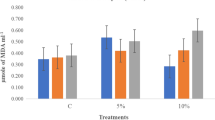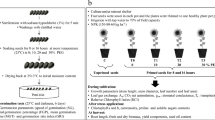Abstract
A common problem with vegetable production in saline areas is poor crop stand, but for black cumin (Nigella sativa L.) germination data are limited and inconsistent. The effects of chemical priming with Urmia lake salt and urea solutions for 16 h at 30 °C on seed germination and seedling growth of black cumin (Nigella sativa L.) were studied under various osmotic stress levels. For a more detailed assessment of chemical priming, the effects of hydropriming for 16 h at 30 °C were also studied. A seed lot that was not exposed to any treatment, except disinfection, was used as control. Osmotic stress levels were − 2, − 4, − 6, and − 8 bar, which were achieved with polyethylene glycol 6000 (PEG 6000). Seed germination of black cumin was reduced by 16.2%, 33.8%, 50.9%, and 74.9% under osmotic potential − 2, − 4, − 6, and − 8 bar, respectively, compared with non-stressed control. Improved germination index values, reduced mean germination time, and increased coefficients of velocity of germination were observed under osmotic stress in primed seeds compared with non-primed control. Averaged over priming treatments, priming improved the final germination percentage by 10.5%, 24.3%, 45.5%, and 74.6% under osmotic potential − 2, − 4, − 6, and − 8 bar, respectively. Post-germination growth was also inhibited under low osmotic potential compared with the non-stressed control. Nevertheless, priming improved length and weight of black cumin seedlings and enhanced peroxidase and catalase activity at all osmotic potential levels compared with non-primed seeds. Higher seedling vigor indices were recorded in seedlings from primed seeds with decreasing osmotic potential levels than non-primed seeds. Urmia lake salt priming had the greatest impact on improving seed germination and vigor indices, especially under osmotic stress conditions. Although seed priming did not completely eliminate the symptoms of osmotic stress in black cumin germination, it is an efficient method to mitigate the impact of osmotic stress on germination of this species.








Similar content being viewed by others
References
Abdul-Baki A, Anderson JD (1973) Vigor determination in soybean seed by multiple criteria. Crop Sci 13:630–633
Afzal I, Rauf S, Barsa SMA, Murtaza G (2008) Halopriming improves vigour, metabolism of reserves and ionic contents in wheat seedlings under salt stress. Plant Soil Environ 54:382–388
Ahmadzadeh Kokya T, Pejman AH, Mahin Abdollahzadeh E, Ahmadzadeh Kokya B, Nazariha M (2011) Evaluation of salt effects on some thermodynamic properties of Urmia Lake water. Int J Environ Res 5:343–348
Alipour S (2006) Hydrogeochemistry of seasonal variation of Urmia salt lake, Iran. Saline Syst 2:1–9
Amirnia R, Ghiyasi M (2016) Reducing drought stress effects in germination and establishment stage of cumin (Cuminum cyminum L.) by seed priming. J Appl Biol Sci 10:24–26
AOSA (1983) Seed vigour testing handbook. Association of Official Seed Analysts. Ithaca
Ashraf M (2004) Some important physiological selection criteria for salt tolerance in plants. Flora 199:361–376
Ashraf M, McNeilly T, Bradshaw AD (1986) The response of selected salt-tolerant and normal lines of four grass species to NaCl in sand culture. New Phytol 104:453–461
Bakht J, Shafi M, Jamal Y, Sher H (2011) Response of maize (Zea mays L.) to seed priming with NaCl and salinity stress. Span J Agric Res 9:252–261
Bor M, Ozdemir F, Turkan I (2003) The effect of salt stress on lipid peroxidation and antioxidants in leaves of sugar beet Beta vulgaris L. and wild beet Beta maritime L. Plant Sci 164:77–84
Bose B, Mishra T (1992) Response of wheat seed to pre sowing seed treatments with Mg(NO3). Ann Agric Res 13:132–136
Cherel L (2004) Regulation of K+ channel activities in plant from physiological to molecular aspects. J Exp Bot 55:337–351
Demiral T, Turkan I (2005) Comparative lipid peroxidation, antioxidant systems and proline content in roots of two rice cultivars differing in salt tolerance. Environ Exp Bot 53:247–257
Du Z, Bramlage WJ (1992) Modified thiobarbituric acid assay for measuring lipid oxidation in sugar-rich plant tissue extracts. J Agric Food Chem 40:1566–1570
Eimanifar A, Mohebbi F (2007) Urmia Lake (northwest Iran): a brief review. Saline Syst 3:1–5
Ellis RH, Roberts EH (1981) The quantification of aging and survival in orthodox seeds. Seed Sci Technol 9:373–409
Farhoudi R, Sharifzadeh F (2006) The effects of NaCl priming on salt tolerance in canola (Brassica napus L.) seedlings grown under saline conditions. Indian J Crop Sci 1:74–78
Ghiyasi M, Seyahjani AA, Tajbakhsh M, Amirnia R, Salehzadeh H (2008) Effect of osmopriming with polyethylene glycol (8000) on germination and seedling growth of wheat (Triticum aestivum L.) seeds under salt stress. Res J Biol Sci 3:1249–1251
Ghiyasi M, Amirnia R, Fazelimanesh M (2015) The effect of seed priming with different concentrations of ascorbic acid on germination and vigor of cumin (Cumin cyminum L.) under saline conditions. Thai J Agric Sci 48:179–785
Gholami M, Mokhtarian F, Baninasab B (2015) Seed halopriming improves the germination performance of black seed (Nigella sativa) under salinity stress conditions. J Crop Sci Biotechnol 18:21–26
Gobinathan P, Sankar B, Murali PV, Panneerselvam RN (2009) Effect of calcium chloride on salinity—induced oxidative stress in Pennisetum typoidies. Bot Res Int 2:143–148
Gondim FA, Gomes-Filho E, Costa JH, Mendes Alencar NL, Prisco JT (2012) Catalase plays a key role in salt stress acclimation induced by hydrogen peroxide pretreatment in maize. Plant Physiol Biochem 56:62–71
Hajar AS, Zidan MA, Al-Zahrani HS (1996) Effect of salinity stress on the germination, growth and some physiological activities of black cumin (Nigella sativa L.). Arab Gulf J Sci Res 14:445–454
Hasanuzzaman M, Nahar K, Fujita M (2012) Plant response to salt stress and role of exogenous protectants to mitigate salt-induced damages. In: Ahmad P et al. (eds) Ecophysiology and responses of plants under salt stress. Springer Science + Business Media, Berlin, pp 25–87
Iqbal M, Ashraf M, Jamil A, Ur-Rehman S (2006) Does seed priming induce changes in the levels of some endogenous plant hormones in hexaploid wheat plants under salt stress. J Integr Plant Biol 48:181–189
Maguire JD (1962) Speed of germination—aid in selection and evaluation for seedling emergence and vigour. Crop Sci 2:176–177
Michel BE, Kaufmann MR (1973) The osmotic potential of polyethylene glycol 6000. Plant Physiol 51:914–916
Papastylianou P, Bakogianni NN, Travlos I, Roussis I (2018) Sensitivity of seed germination to salt stress in black cumin (Nigella sativa L.). Not Bot Horti Agrobot Cluj-Napoca 46:202–205
Patade VY, Maya K, Zakwan A (2011) Seed priming mediated germination improvement and tolerance to subsequent exposure to cold and salt stress in capsicum. Res J Seed Sci 4:125–136
Salehzade H, Shishvan MI, Ghiyasi M, Forouzin F, Siyahjani AA (2009) Effect of seed priming on germination and seedling growth of wheat (Triticum aestivum L.). Res J of Biol Sci 4:629–631
Savvides A, Ali S, Tester M, Fotopoulos V (2016) Chemical priming of plants against multiple abiotic stresses: mission possible? Trends Plant Sci 21:329–340
Shalhevet J (1995) Using marginal quality water for crop production. Int Water Irrig Rev 15:5–10
Sudhakar C, Lakshmi A, Giridarakumar S (2001) Changes in the antioxidant enzyme efficacy in two high yielding genotypes of mulberry (Morus alba L.) under NaCl salinity. Plant Sci 161:613–619
Summart J, Thanonkeo P, Panichajakul S, Prathepha P, McManus MT (2010) Effect of salt stress on growth, inorganic ion and proline accumulation in Thai aromatic rice, Khao Dawk Mail 105, callus culture. Afr J Biotechnol 9:145–152
Tajbakhsh M, Ghiyasi M (2009) Seed ecology. Jahde-Daneshghahi. Urmia University, Urmia, Iran
Taylor AG, Harman GE (1990) Concepts and technologies of selected seed treatments. Ann Rev Phytopathol 28:321–339
Turkan I, Bor M, Ozdemir F, Koca H (2005) Differencial responses of lipid peroxidation and antioxidants in the leaves of drought-tolerant P. acutifolius gray and drought sensitive P. vulgaris L. subjected to polyethylene glycol mediated water stress. Plant Sci 168:223–231
Yamazaki J, Ohashi A, Hashimoto Y, Negishi E, Kumagai S, Kubo T, Oikawa T, Maruta E, Kamimura Y (2003) Effects of high light and low temperature during harsh winter on needle photodamage of Abies mariesii growing at the forest limit on Mt. Norikura in Central Japan. Plant Sci 165:257–264
Author information
Authors and Affiliations
Corresponding authors
Ethics declarations
Conflict of interest
The authors declare no conflict of interest.
Rights and permissions
About this article
Cite this article
Ghiyasi, M., Siavash Moghaddam, S., Amirnia, R. et al. Chemical Priming with Salt and Urea Improves Germination and Seedling Growth of Black Cumin (Nigella sativa L.) under Osmotic Stress. J Plant Growth Regul 38, 1170–1178 (2019). https://doi.org/10.1007/s00344-019-09922-z
Received:
Accepted:
Published:
Issue Date:
DOI: https://doi.org/10.1007/s00344-019-09922-z




